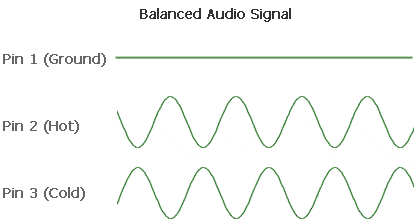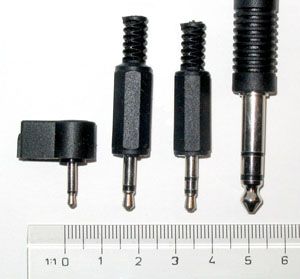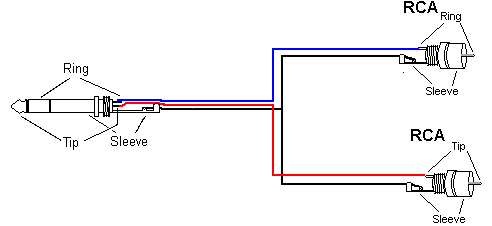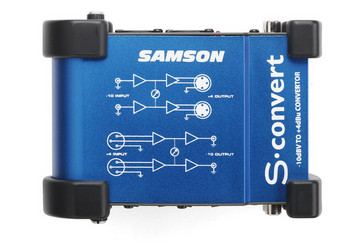BALANCED CABLES
A balanced cable has three wires, one for ground (earth), one for the positive (hot), and one for the negative (cold).

Common Balanced Connectors
The two most common balanced connectors are XLR and TRS.
XLR Connectors:
In the case of an XLR cable, the three wires are called, X (ground), L (left, hot) and R (right, cold). There are both male and female XLR connectors.
Pin 1: Shield (G)
Pin 2: Hot (L)
Pin 3: Cold (R)


XLR Connectors
TRS Connectors:
TRS is the abbreviation for Tip (Left), Ring (Right), Sleeve (Shield, Ground). Although it may look like a standard 1/4" (6.35 mm) or 1/8" (3.5 mm) phono plug, it does have an extra ring on its shaft. TRS cables have two conductors plus a ground (shield). A TRS cable can carry either a balanced mono audio signal or an unbalanced stereo audio signal.

TRS Connector
How Does Audio Transmitted in Balanced Cables?
The audio signal is transmitted at the source on both the positive (L) and negative (R) lines, but the voltage in the negative (R) line is inverted (i.e. the polarity is changed). When the signal is positive on the hot (L) line, it is negative on the cold line (R). They appear as if they are 180 degrees out of phase. However, it is more technically correct to say one signal has reverse polarity. The signal in the left (R) line is not delayed 180 degrees. It is only flipped upside down.

Removing Noise at the Destination
It is possible that along the length of the cable, noise is encountered from external sources such as other electronic devices or RF interference. This noise will be identical on both hot and cold lines. When the balanced XLR cable is plugged into the input of other balanced equipment, the cold (R) line is inverted again. Now the two audio signals in both hot (L) and cold (R) lines are identical in every way. However, the noise that was introduced along the way is now inverted on the R line. When the L and R signals are combined at the destination, the inverted noise on the R line is combined with the original noise on the L line, they cancel each other out. All that is left is the original audio signal.
Fully Differential Balanced Circuit Design
Most professional audio products provide balanced inputs and outputs through XLR or TRS connectors. In almost all cases, a balanced input signal is internally converted to an unbalanced (single-ended) signal by using a transformer or amplifier. After the internal processing is finished, the signal is converted back to balanced signal and sent to an XLR/TRS output.
A very small number of professional products may exist that use balanced signal from input to output without ever converting it to unbalanced signal. This is referred to as fully differential balanced circuit design. In very critical applications (not home theater), such a design offers better signal integrity by avoiding the extra transformers or amplifiers required for unbalancing and rebalancing. It is claimed by promoters that fully balanced internal circuitry can yield 3dB of additional dynamic range. Don't believe everything that is claimed.
UNBALANCED CABLES
An unbalanced cable has two wires, one for the positive and one that acts as both the negative and the ground. Because the negative wire has to do more work than the positive wire, such a configuration is called Unbalanced.

Common Unbalanced Connectors
The two most common unbalanced connectors are RCA and TS phono jack. Even XLR cables be used for transmitting unbalanced audio. Unbalanced speaker connectors are speakon, and banana plugs.
RCA Connectors:
RCA connectors are associated with the RCA Corporation. Most home audio/video equipment use RCA connectors. They are even used for S/PDIF connections in digital transmission of audio signal.




RCA Connectors
TS Connectors:
There are 1/4" (6.35 mm) or 1/8" (3.5 mm) TS jacks. TS is the abbreviation for Tip and Sleeve. One insulator ring separates the tip and sleeve. The tip is considered to be the positive (hot) and the sleeve is the ground or shield is connected. The most common applications of TS cables are in guitar or line-level instrument connections.

1/4" TS Connector
COMPARISON OF TRS AND TS JACKS
TS and TRS connectors look almost identical. Some equipment accept a TS connector in a TRS socket, but it may be a good idea to check the equipment documentation to be sure. Remember that 1/4" TS connectors connect to –10 dBV line level equipment, whereas 1/4" TRS connectors expect a +4 dBu line level (for explanation, see the section below on balanced vs. unbalanced reference voltage levels).

- Sleeve: Ground (Shield)
- Ring: Right channel for stereo signals, negative polarity for balanced mono signals, power supply for power-using mono signal sources
- Tip: Left channel for stereo signals, positive polarity for balanced mono signals, signal (hot) line for unbalanced mono signals
- Insulating rings
Phone jack connectors are available in 1⁄4" (6.35 mm), 1/8" (3.5 mm), and 3/32" (2.5 mm) sizes. All three sizes are now readily available in two-conductor (unbalanced mono) and three-conductor (balanced mono or unbalanced stereo) versions.

2.5 mm mono (TS), 3.5 mm mono (TS), 3.5 mm stereo (TRS), and 6.35 mm (1⁄4 in) (TRS) phone connectors
If a mono TS plug is inserted into three-conductor stereo TRS socket, the result is that the right channel (ring) of the socket is grounded. The signal from the right channel will be lost. If the grounding of the right channel short circuits the right channel of the amplifier, this could damage the amplifier.
MIXING WIRING CONFIGURATIONS
One Mono XLR Connector to One RCA Connector:
When connecting a 3-pin XLR to one RCA, the negative (-ve) and shield of the XLR are joined together, either at the RCA end or at the XLR end. The end result will be unbalanced.


Stereo TRS Phono Jack to Two RCA Connectors:
When a stereo 1/4" phono jack is used, the left and right parts of the stereo signal are split off to two separate connectors.

One Mono XLR Connector to 1/4" (6.35 mm) TRS Connector:
Normally, the 3-pin XLR is connected to a 1/4" TRS phono jack for balanced mono applications as in the following. This type of wiring will give you a balanced mono connection.
- Pin of XLR to TRS Phono Jack Sleeve
- Pin 2 of XLR to TRS Phono Jack Tip
- Pin 3 of XLR to TRS Phono Jack Ring

One Mono XLR to One 1/4" or 1/8" Mono TS Phono Jack:
When connecting a 3-pin XLR to one mono TS phono jack, the negative (-ve) and shield of the XLR are joined together, either at the phono jack end or at the XLR end, and connected to the sleeve of the phono jack. The end result will be unbalanced.


ADVANTAGES AND DISADVANTAGES
A balanced XLR cable has three major advantages over an unbalanced RCA cable and that is why pro users prefer them.
These are the advantages:
- XLR connectors are more robust. They do not come loose as easily as RCA cables. Imagine in the middle of a rock concert with lots of speakers, amplifiers, cables, and all the craziness, some RCA cables become loose. You will have a riot.

- Because they are balanced and are grounded better, XLR cables are relatively noise free. RCA cables, on the other hand, can drive you crazy with noise and hum.
- There is a limit on how long you can make an RCA cable (normally below 10 meters) before it significantly attenuates the signal. XLR cables can be as long as a few hundred feet.
- Unbalanced RCA cables are less complicated.
- They are less expensive.
- They are readily available in almost all retail stores.
- Many manufacturers include them with their products.
If the signal is unbalanced out of you receiver, it will arrive that way. Using an RCA to XLR cable will not be of any advantage nor will an RCA to a balanced 1/4''. When you use a cable with an unbalanced RCA connector on one side and a balanced XLR connector on the other side, the end result will become unbalanced and you will lose all the advantages of an XLR cable. That is why the use of a converter box such (described below) is recommended.
USING BALANCED/UNBALANCED LINE LEVEL CONVERTERS
Balanced and Unbalanced Reference Voltage:
For consumer audio products using unbalanced RCA connectors, the reference signal level is -10dBV. This is equal to reference voltage level of 0.316 Vrms. 0 dBV is a voltage reference point equal to 1.0 Vrms. Remember that the dB level is a LOG ratio of two voltages.
=20*LOG(0.316/1) ˜ -10 dB
For pro audio products using balanced XLR connectors, the reference signal level is +4dBu. This is equal to voltage reference level of 1.23 Vrms. 0 dBu is a voltage reference point equal to 0.775 Vrms.
=20*LOG(1.23/0.775) ˜ +4 dB
When a home audio equipment with an RCA output is connected to a pro audio equipment’s XLR input, the signal will have to increase by as much as 12 dB. The casual observer would think to convert -10 dBV to +4 dBu, you would need 14 dB of gain. The casual observer would be wrong. You only need 12 dB of gain. The reason is not only do you change levels, you also change reference levels -- from dBV to dBu. The first (dBV) references everything to 1.0 volt, while the second (dBu) references everything to 0.775 volts.
=20*LOG(1.23/0.316) ˜ 12 dB
As soon as you make an unbalanced connection at one end of a wire, the whole thing becomes unbalanced. So for maximum noise immunity, you should use balancing adapters.
Unbalanced lines should always be kept under 10 feet (3 meters) to prevent undesirable effects such as hum and noise. There are balancing transformers available for long runs of cables. For example, if a microphone with XLR connectors is to be connected to a prosumer camcorder, an XLR adapter such asBeachTek or Studio 1 should be used for converting unbalanced outputs to balanced lines, allowing for long runs of XLR cable.
Converter Boxes:
A converter box can solve input/output level problems for level matching consumer and professional audio equipment. For example, if you use an RCA to XLR cable from your receiver/preamp to your amplifier, you will notice a drop of a few dBs. The biggest advantage that XLR offers is grounding and less noise problems. A lot of time, when you connect an RCA device to an XLR device, the level may not be sufficient and you need to increase the output level of the source to match the input level of the destination. For example, I own a couple of pro amplifiers with XLR inputs to power seveal passive subwoofers. I bought two Samson S-Convert boxes to connect the unbalanced line output from the receiver to the XLR inputs on the back of the pro amplifiers.

This is from the Manual:
Quote:
| S-convert provides a convenient solution for matching levels and interfacing audio devices, either on stage or in the studio. The S convert is a specially designed miniature level matching device that allows you to convert stereo –10dBV (RCA) signals like those from consumer CD players and cassette recorders, to +4 dBu (XLR) signals like those from professional mixers, outboard effects processors and DAT machines to name some. The S-convert works in both directions and features male and female XLR connectors for the balanced +4dBu inputs and outputs, along with RCA connectors for the unbalanced –10dBV inputs and outputs. The addition of +4 and –10 LEVEL controls allows you to use S-convert to calibrate your signals to an exact level. |
In my case, I connected the Samson S-Convert between the subwoofer output on the back of the receiver and the Behringer EP4000 amplifier. The basic procedure is summarized below:
- Connect the sub cable to the RCA input of S-Convert.
- Connect the XLR output of the Samson S-Convert to the XLR input #1 of the Behringer amplifier with a female XLR to male XLR cable.
- Leave the level controls of the Samson S-Covert at the default.
I highly recommend a converter box for balanced to unbalanced connections. Samson no longer sells the S-Convert. You can buy Art CleanBox Pro or Rolls from Amazon or other pro audio dealers.


